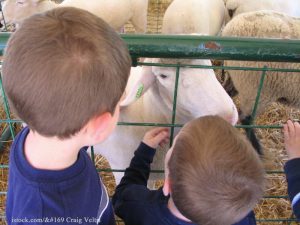Contact with farm animals might be a bigger cause of bovine-associated salmonellosis in humans than we thought, according to a study published in the December volume of Emerging Infectious Disease, a scientific journal produced by the Centers for Disease Control and Prevention (CDC). So, prevention efforts, which mostly focus on foodborne transmission, should be broadened to include animal contact, the study suggests. That would include farm workers, cattle producers, petting zoos or animal exhibits at fairs.
 Researchers suggest several preventative measures that minimize the likelihood of becoming infected with Salmonella from direct contact with farm animals. The first is washing hands with soap and water. The second, the high-risk group which include children under five, seniors, pregnant women and others with compromised immune systems “pay special attention to hygiene or avoid certain animal contacts altogether.” Third, veterinarians should educate farm employees and others who work with cattle “to wash well after work or before eating, to disinfect boots and equipment, and to keep coveralls out of the house.”
Researchers suggest several preventative measures that minimize the likelihood of becoming infected with Salmonella from direct contact with farm animals. The first is washing hands with soap and water. The second, the high-risk group which include children under five, seniors, pregnant women and others with compromised immune systems “pay special attention to hygiene or avoid certain animal contacts altogether.” Third, veterinarians should educate farm employees and others who work with cattle “to wash well after work or before eating, to disinfect boots and equipment, and to keep coveralls out of the house.”
Salmonella is a bacteria that causes gastrointestinal illness if ingested. Symptoms include abdominal cramping, vomiting and diarrhea which can sometimes be bloody. Each year, roughly 1.2 million people contract salmonellosis, about 400 of those cases are fatal. The incidence of human salmonellosis is now significantly higher now than it was during 2006–2008, according to the CDC.
Researchers, Kevin J. Cummings , Lorin D. Warnick, Margaret A. Davis, Kaye Eckmann, Yrjö T. Gröhn, Karin Hoelzer, Kathryn MacDonald, Timothy P. Root, Julie D. Siler, Suzanne M. McGuire, Martin Wiedmann, Emily M. Wright, Shelley M. Zansky, and Thomas E. Besser studied Salmonella in 835 case patients in New York and 562 case patients in Washington state, from March 1, 2008, through March 1, 2010. They found that contact with farm animals during the 5 days before illness onset was “significantly associated with contracting salmonellosis. The odds ratio was 3.2, p = 0.0008 after consumption of undercooked ground beef and unpasteurized milk were controlled for and 7.4, p = 0.0002 after food exposures were controlled for.
The risk is greater for people who have regular contact with cows than for those who might visit a cow exhibit at a petting zoo. “Although attendance at an open farm/petting zoo/fair was not significantly associated with being a case-patient in this study, it is logical to believe that visiting such a facility might increase the risk for salmonellosis, on the basis of our other findings. [Salmonella] is transmitted primarily by the fecal–oral route.
“Direct contact with the feces of infected cattle can occur through feeding, petting, or otherwise handling them; contaminated clothing or footwear, animal bedding, barriers, or other environmental surfaces can also be sources of infection. This threat is underscored by the recent finding that the median duration of fecal Salmonella shedding following clinical disease among dairy cattle is 50 days,” the study notes.




